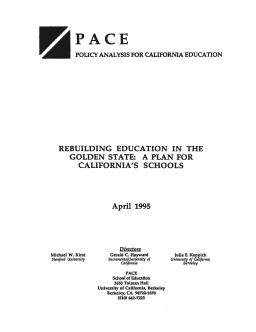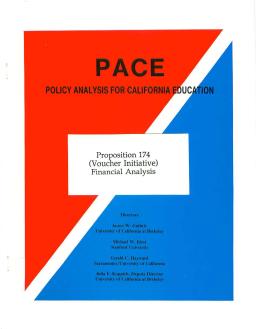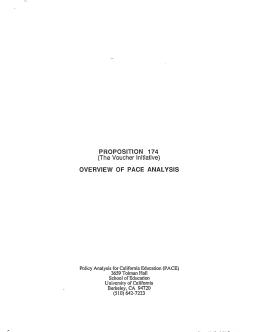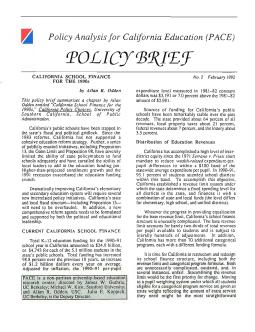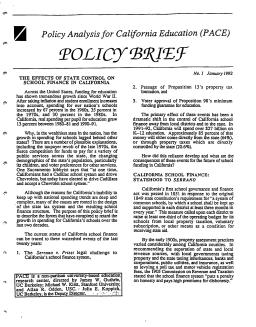Published
Summary
This study examines student mobility in California, particularly at the secondary level. It investigates the incidence, consequences, and causes of non-promotional school changes and offers strategies to address the issue. It also draws on an extensive dataset from various sources, including surveys and interviews with California students, parents, and schools. The findings highlight the negative impact of student mobility on educational achievement and suggest that families, schools, community agencies, and policymakers should take action to mitigate its harmful effects.
A Plan for California’s Schools
Published
Summary
In 1990, PACE issued a plan for CA schools, addressing the challenges of explosive growth, increasing diversity, and lagging student achievement. Five years later, PACE has revised the plan to include measurable statewide education goals, a new student assessment system, teacher education reforms, and the goal of English proficiency for all students. Other recommendations include school finance reform, coordination between schools and social services, evaluation of local reform efforts, experiments to improve student achievement, and linking school-to-career policy with education reform.
Financial Analysis
Published
Summary
The Californians will vote on Proposition 174 which will amend the state constitution to establish "scholarships" for kindergarten to 12th-grade schooling. These new schools will be publicly funded but may have privately selected governing boards and religious orientation. It is unclear whether they will be public or private schools. The paper attempts to reduce uncertainty regarding the financial consequences of the proposed voucher plan and address questions about public costs and possible cost savings.
Overview of PACE Analysis
Published
Summary
Policy Analysis for California Education (PACE) has analyzed the financial, legal, and social ramifications of Proposition 174, the school choice initiative, to provide Californians and policymakers with accurate, unbiased information. This brief contains important questions and answers about the initiative, summaries of PACE's financial analysis and polling report, and background information on PACE and its directors. PACE has published five separate analyses of Proposition 174, covering financial impacts, legal considerations, public opinion, and comparisons with other school choice efforts...
The School Voucher Initiative
Published
Summary
The "Parental Choice in Education Initiative" or Proposition 174, will be voted on by Californians on November 2, 1993. PACE has conducted an analysis of the initiative's provisions to provide objective information to policymakers, parents, educators, and the public. PACE is not taking a stance on the initiative but has produced additional materials related to the initiative and the issue of school choice. These materials are listed in the attached report on school choice.
Published
Summary
California's education reform strategy includes creating high-quality curriculum frameworks to upgrade K-12 education, which raise expectations for students' knowledge and understanding of language arts, mathematics, science, and history/social science. The frameworks focus on learning for understanding, problem-solving, and applying knowledge to real-life situations. The goals are to produce students who know how to learn, analyze issues, solve problems, and apply their knowledge to real-world problems.
Published
Summary
California's public school student achievement is improving but still has a ways to go to meet world class standards. Increasing enrollments, declining revenues, and political issues are distracting from education reform. This policy brief seeks to bring attention to building public visibility and political consensus around national strategies for accelerating education reform. The message is not that California's public education system will be subordinated to a monolithic national reform effort.
Published
Summary
California's education system has suffered from a lack of cohesive reform strategy since 1983 due to political and fiscal gridlock, and initiatives like Proposition 13 have limited state and local leaders' ability to fund schools adequately. To improve the system, California needs to overhaul its fiscal structure and formulate a new comprehensive reform agenda with the support of both political and educational leadership.
Published
Summary
Funding for education in the US has grown significantly since World War II, but in California, spending for schools has lagged behind other states. Reasons for this include the taxpayer revolt of the late 1970s, competition for funds, changing demographics, and voter preferences. Many of the causes are rooted in the state tax system and school finance structure. Californians used to have a top school system but now have a lower-quality one due to these factors.

